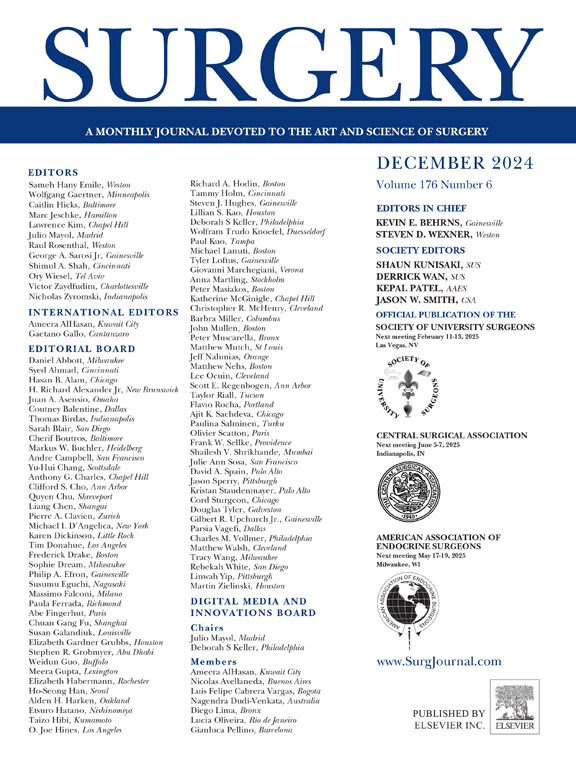Postoperative hepatic insufficiency despite preoperative portal vein embolization: Not just about the volumetrics
IF 3.2
2区 医学
Q1 SURGERY
引用次数: 0
Abstract
Background
Future liver remnant hypertrophy is the primary endpoint of portal vein embolization before major hepatectomy. However, even when adequate future liver remnant is achieved, postoperative hepatic insufficiency is not universally averted. We aimed to identify preoperative risk factors of postoperative hepatic insufficiency despite the use of portal vein embolization.
Methods
Patients who underwent portal vein embolization followed by major hepatectomy at 6 academic medical centers were retrospectively reviewed. Postoperative hepatic insufficiency was defined as postoperative peak bilirubin >7 mg/dL. Preoperative variables associated with postoperative hepatic insufficiency were analyzed.
Results
From 2008 to 2019, 164 patients underwent portal vein embolization followed by major hepatectomy. Twenty (12%) patients developed postoperative hepatic insufficiency. On univariate analysis, postoperative hepatic insufficiency was associated with older age, performance status, preoperative biliary drainage, smaller pre- and post-portal vein embolization future liver remnant volumes, diagnosis of cholangiocarcinoma/gallbladder cancer, and preoperative cholangitis. There was significant future liver remnant hypertrophy noted even in the setting of postoperative hepatic insufficiency (from 27% to 39%); however, degree of hypertrophy >5% (100% vs 93%, P = .6) and kinetic growth rate >2%/week (95% vs 82%, P = .3) did not differ between the postoperative hepatic insufficiency and non-postoperative hepatic insufficiency groups. On multivariate analysis, the diagnosis of cholangiocarcinoma/gallbladder cancer and preoperative cholangitis (postoperative hepatic insufficiency incidence 34% and 62%, respectively), but not future liver remnant volumetrics, were independently associated with postoperative hepatic insufficiency. Postoperative hepatic insufficiency raised post-hepatectomy 90-day mortality from 3.5% to 45% and hospitalization from 7 days to 16 days (both P < .001).
Conclusion
Postoperative hepatic insufficiency still occurs in 12% of patients after major hepatectomy despite preoperative portal vein embolization. In addition to traditional volumetric information, surgeons should be aware of preoperative cholangitis and cholangiocarcinoma/gallbladder cancer as powerful predictors of this fatal complication.

求助全文
约1分钟内获得全文
求助全文
来源期刊

Surgery
医学-外科
CiteScore
5.40
自引率
5.30%
发文量
687
审稿时长
64 days
期刊介绍:
For 66 years, Surgery has published practical, authoritative information about procedures, clinical advances, and major trends shaping general surgery. Each issue features original scientific contributions and clinical reports. Peer-reviewed articles cover topics in oncology, trauma, gastrointestinal, vascular, and transplantation surgery. The journal also publishes papers from the meetings of its sponsoring societies, the Society of University Surgeons, the Central Surgical Association, and the American Association of Endocrine Surgeons.
 求助内容:
求助内容: 应助结果提醒方式:
应助结果提醒方式:


